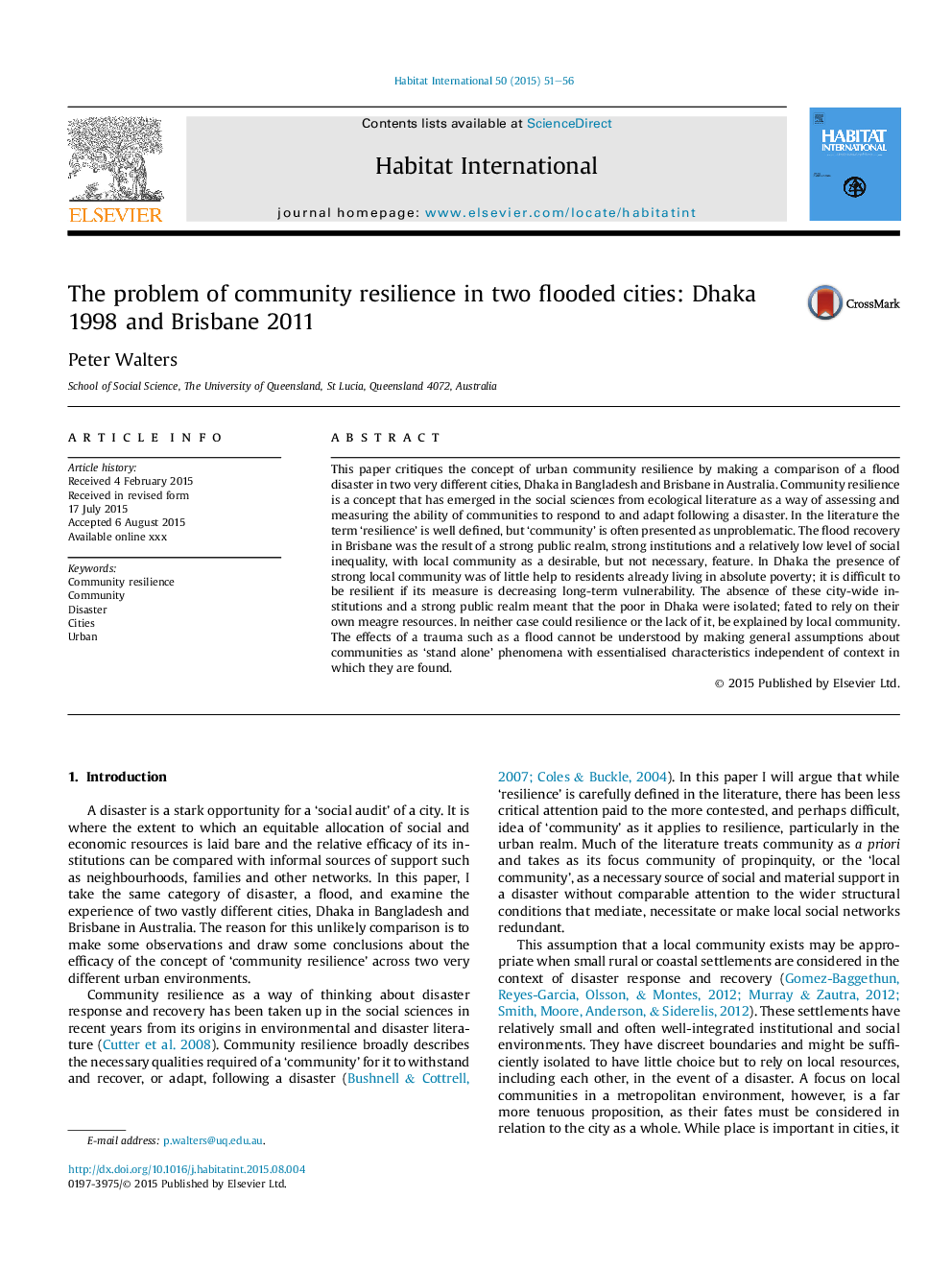| کد مقاله | کد نشریه | سال انتشار | مقاله انگلیسی | نسخه تمام متن |
|---|---|---|---|---|
| 7455811 | 1484493 | 2015 | 6 صفحه PDF | دانلود رایگان |
عنوان انگلیسی مقاله ISI
The problem of community resilience in two flooded cities: Dhaka 1998 and Brisbane 2011
ترجمه فارسی عنوان
مشکل انعطاف پذیری جامعه در دو شهر آب گرفتگی: داکا 1998 و بریزبن 2011
دانلود مقاله + سفارش ترجمه
دانلود مقاله ISI انگلیسی
رایگان برای ایرانیان
کلمات کلیدی
انعطاف پذیری جامعه، جامعه فاجعه، شهرها، شهری،
ترجمه چکیده
این مقاله با مقایسه مقیاس یک فاجعه سیلاب در دو شهر بسیار متفاوت، داکا در بنگلادش و بریزبن استرالیا، مفهوم انعطاف پذیری جامعه شهری را ارزیابی می کند. انعطاف پذیری جامعه یک مفهوم است که در علوم اجتماعی از ادبیات زیست محیطی به عنوان راهی برای ارزیابی و سنجش توانایی جوامع برای پاسخگویی و انطباق پس از یک فاجعه ظهور کرده است. در ادبیات اصطلاح "انعطاف پذیری" به خوبی تعریف شده است، اما "جامعه" اغلب به عنوان غیر مشکلی ارائه می شود. بهبودی سیلاب در بریزبن نتیجه یک قلمرو قدرتمند عمومی، نهادهای قوی و سطح نسبتا پایین نابرابری اجتماعی بود، و جامعه محلی به عنوان مطلوب، اما ضروری نیست. در داکا، حضور جامعه محلی قوی، برای ساکنان که در فقر مطلق زندگی می کنند، کمی کمک می کند؛ اگر اندازه آن آسیب پذیری طولانی مدت را کاهش دهد دشوار است که انعطاف پذیر باشد. فقدان این نهادهای شهری و یک قلمرو عمومی عمومی به این معنا بود که فقرا در داکا جدا شده بودند؛ مشتاق به منابع ناچیز خود تکیه می کنند. در هر صورت، انعطاف پذیری یا فقدان آن، توسط جامعه محلی توضیح داده شود. اثرات یک تروما مانند سیل، نمی توان با ایجاد مفروضات عمومی درباره جوامع به عنوان پدیده مستقل با خصوصیات اساسی مستقل از زمینه که در آن یافت می شود، درک نمی شود.
موضوعات مرتبط
علوم انسانی و اجتماعی
علوم اجتماعی
توسعه
چکیده انگلیسی
This paper critiques the concept of urban community resilience by making a comparison of a flood disaster in two very different cities, Dhaka in Bangladesh and Brisbane in Australia. Community resilience is a concept that has emerged in the social sciences from ecological literature as a way of assessing and measuring the ability of communities to respond to and adapt following a disaster. In the literature the term 'resilience' is well defined, but 'community' is often presented as unproblematic. The flood recovery in Brisbane was the result of a strong public realm, strong institutions and a relatively low level of social inequality, with local community as a desirable, but not necessary, feature. In Dhaka the presence of strong local community was of little help to residents already living in absolute poverty; it is difficult to be resilient if its measure is decreasing long-term vulnerability. The absence of these city-wide institutions and a strong public realm meant that the poor in Dhaka were isolated; fated to rely on their own meagre resources. In neither case could resilience or the lack of it, be explained by local community. The effects of a trauma such as a flood cannot be understood by making general assumptions about communities as 'stand alone' phenomena with essentialised characteristics independent of context in which they are found.
ناشر
Database: Elsevier - ScienceDirect (ساینس دایرکت)
Journal: Habitat International - Volume 50, December 2015, Pages 51-56
Journal: Habitat International - Volume 50, December 2015, Pages 51-56
نویسندگان
Peter Walters,
